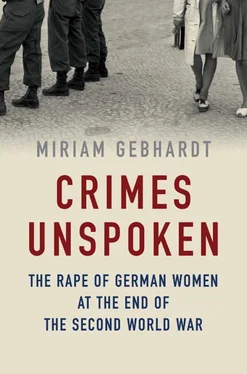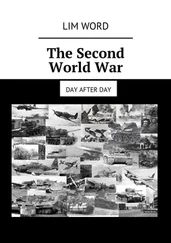To restore the morale of the Germans after 1945, the morality brigade championed two causes: the fight for sexual decency and the rescue of the bourgeois family. A typical example of this was articulated by Peter Schmittingen, priest of the parish of Günzlhofen, in summer 1945:
The foundations of the family had been extensively shaken. The absence of a strict paternal hand, the early and often long separation of husbands and wives, the annoying idleness and pleasure-seeking of young women… the fear for children, particular boys, who so many people believed would merely become cannon fodder, very often also the fear for children on account of future religious concerns, the heavy work and associated emotional fatigue and turmoil, the absence of male friends and the fear of girls that they would never find a husband if they were too choosy and narrow-minded in terms of morality, and other things besides all resulted in a gradual decline in moral standards and a blurring of the lines between good and evil. [27] Pfister, Das Ende des Zweiten Weltkriegs , pp. 602–3.
The author of these lines thus interpreted the Nazi era as a time of moral decay in his own community and blamed the behaviour of women for it. Let it be clearly stated that women were of course also responsible for the Nazi crimes. But this is not what worried the priest; he was concerned, rather, at the weakening of the bourgeois patriarchal social order with its traditional gender roles through the supposedly immoral behaviour of women. After 1945, the finger was quickly pointed at groups of people thought to be particularly responsible for all that was wrong. In many cases it was the city dwellers, evacuees and strangers, who brought shame to the German people on account of their ‘wantonness and dishonourable behaviour towards the Americans’. Another priest from the parish of Ising im Chiemgau put it more bluntly still: they ‘hang around like lazy swine at the lake and stand greedily around the campfires in the hope of getting a piece of chocolate or the like to satisfy their craving. And they dream of perhaps finding someone who will take them away to a far-off land… only forceful discipline can teach respect to these immature and wanton young women.’ [28] Expositus Georg Pfister on 19 July 1945 in Pfister, Das Ende des Zweiten Weltkriegs , p. 465.
After the strangers and the supposedly criminal displaced persons liberated from the camps, the next scapegoats in the conservative post-war morality discussion were the young and women in general – first of all single women, unmarried mothers, ‘infected’ and ‘neglected’ women. [29] See Elizabeth Heineman, ‘The Hour of the Woman: Memories of Germany’s “Crisis Years” and West German National Identity’, in: The American Historical Review , 101, 2 (April 1966), pp. 354–95.
Women who had dealings with the former ‘enemy’ – they were called ‘Veronikas’ – were an ideal target for accusations. Originally, the term referred only to women who had become infected with a venereal disease as a result of sexual contact with the occupying soldiers, known as ‘VD girls’, standing for ‘Veronika Dankeschön’ and also the English abbreviation for venereal diseases. In the US Army, it soon became customary to use this designation for all German women who allegedly thanked their ‘liberators’ by presenting them with a venereal disease. Later, the term was used for all women who were not living in socially accepted circumstances.
In this climate, women who had been raped also quickly came under suspicion. Who knows whether they had been assaulted or whether they had voluntary had sex with the enemy? Was their venereal disease or pregnancy really the result of an act of violence? Did they have witnesses? Or some other proof? Had they gone immediately after the act to a doctor or the police to describe what had happened, or had they preferred not say anything? Wasn’t the rape really a defence to cover up their own dissolute way of life?
It is no exaggeration to state that women who were raped in the late 1940s and early 1950s were symbolically assaulted a second time through the constant questioning of their integrity by neighbours, doctors, officials and other welfare authorities. The post-war discussion of morality exaggerated the problem of female morality to the same extent as it trivialized the actual crimes committed in the Nazi era. Women who were unmarried or not living in respectable circumstances but had venereal diseases and were uprooted, possibly pregnant, were unlikely to have their abuse recognized, because in the strict sense they had no honour that could have been violated. Fallen women, as they were called – in other words, unmarried pregnant girls and prostitutes – were seen as social cases that constituted a danger to the public.
Girls like Anna
The accusation of sexual degeneracy hung like the Sword of Damocles over every woman whose lifestyle was deemed ‘asocial’. Many a young girl who had been sexually abused was labelled in this way. Anna K. was born in East Prussia in 1932. She was one of seven children, and their father worked as a warehouseman. She described her life until the age of twelve as ‘normal’. She went to primary school and felt happy and well looked-after by her parents. The first bombs fell in early 1945, and refugees needed shelter. The family made space, and Anna shared a room with seven others.
One day she heard cries in the next room. She watched a woman giving birth without any assistance. Anna was twelve at the time. ‘It was terrible to watch – and I couldn’t do anything to help. I just stood there, I don’t know how long. When help came, I just heard someone say it was too late. Mother and child were both dead. After I witnessed that, I was no longer a child anymore.’
But there was worse to come. On 27 April 1945, Anna and her family were woken by loud shouting and cries. They quickly got dressed and went to the door. The Soviet soldiers were there. Before she realized the danger, Anna was picked out of the group and dragged away by a Russian. She screamed. He pushed her down into a cellar, stuffed her mouth with a rag and called his comrades. ‘Then they removed my underwear and had their way with me. It was terrible. I don’t know how I got back to my parents.’
Anna K. wrote this report at the end of a stay in a home. The selfexamination had been ordered by the management to find out whether their ‘ward’ had mended her ways. And yet they also illustrate the terrors that Anna had to endure, only to end up in a German institution. After the rape there was the escape. In Königsberg (Kaliningrad), she and other children were ordered to remove corpses from the houses and streets and take them to the woods for burial. Anna got typhoid fever. When she was discharged from hospital five months later, her mother was no longer living. With her father, she now had to look after her remaining siblings aged two, six, nine and eleven years. In early 1947, the dearth of food in the East was so great that the rest of her family starved to death: ‘They died on 5, 25, 29, 30 and 31 January. It was the most terrible time for me because I had to bury my brothers and sisters and my father on my own.’
Left to her own devices, she joined a group of boys who went on forays to find food for themselves. She cut her hair short and wore a jacket so as not to look like a girl. She moved around, later seeking work as a household help, but kept on running away. In this way, she came to the attention of the authorities and ended up in a home. Her greatest wish, she wrote finally in her report, was to find work that she enjoyed, if possible with children. ‘This is basically my life story. I was unfortunately unable to provide more details because my memory of the past is just so terrible to recall’, she concluded. [30] Quoted in Eva Gehltomholt and Sabine Hering, Das verwahrloste Kind: Diagnostik and Fürsorge in der Jugendhilfe zwischen Kriegsende und Reform (1945–1965) (Opladen 2005), pp. 174–5.
Читать дальше











